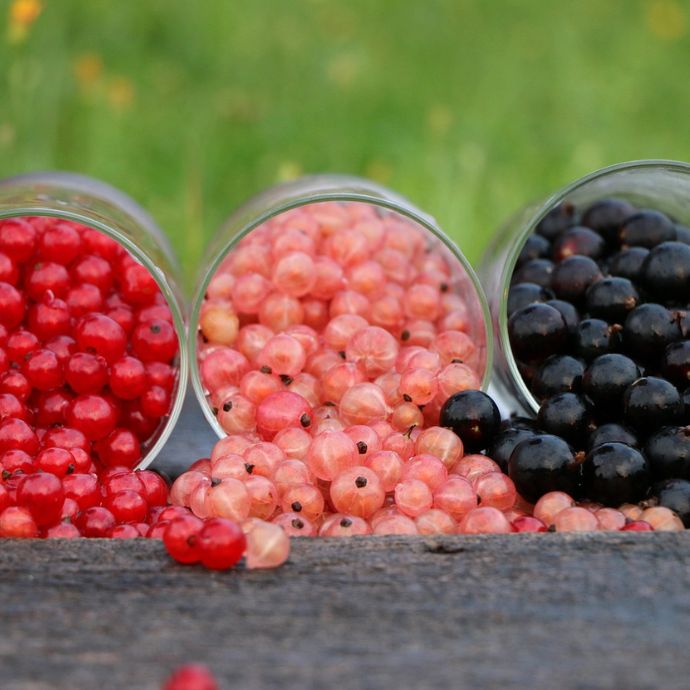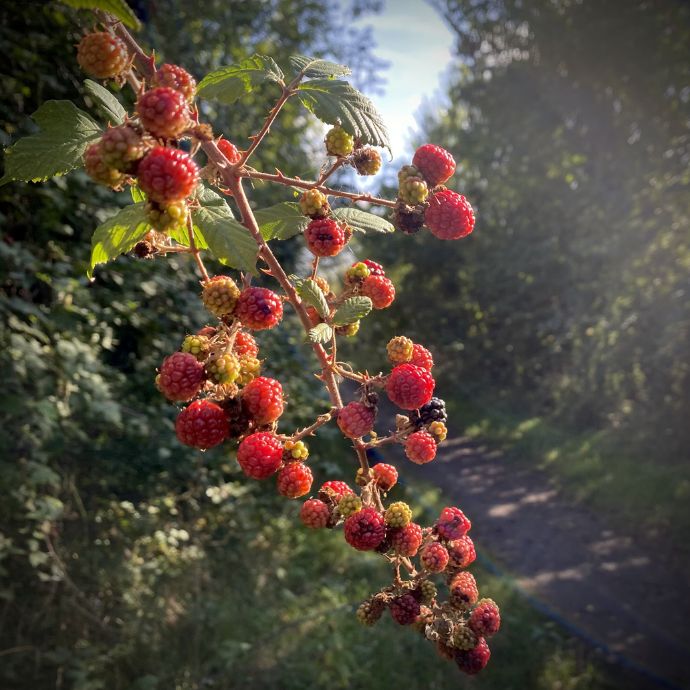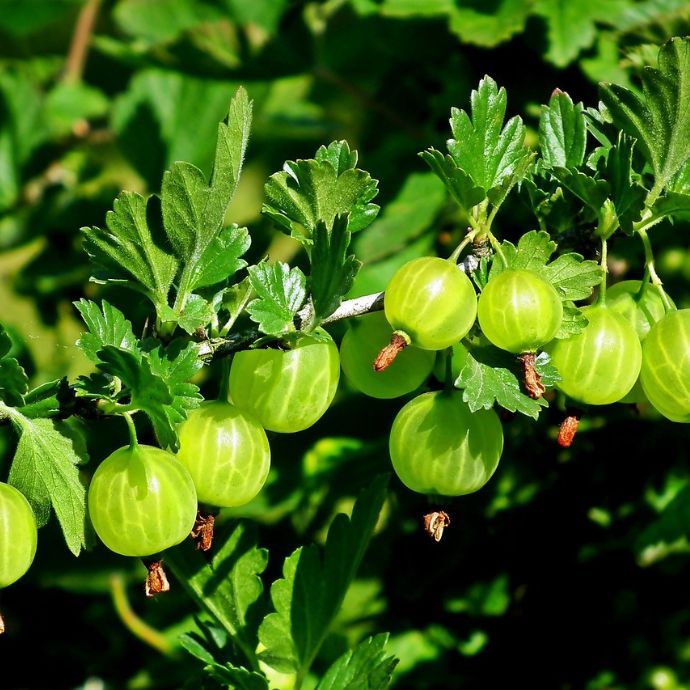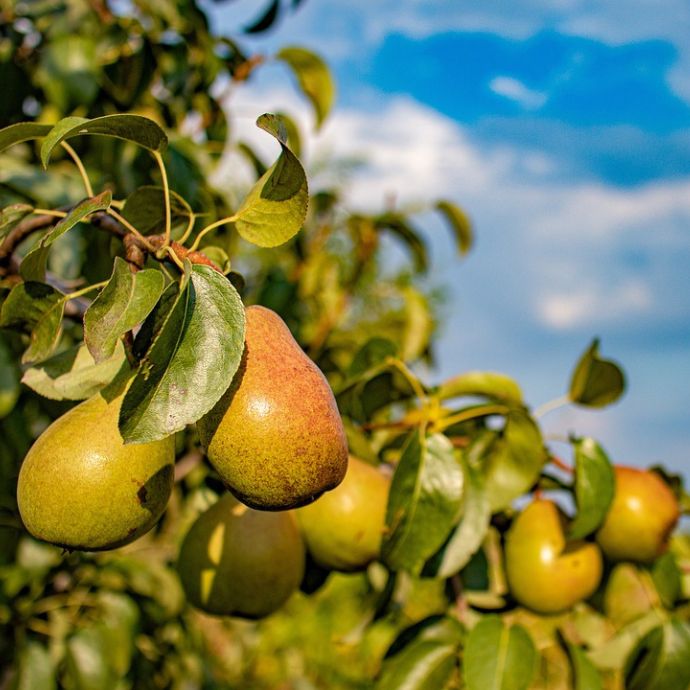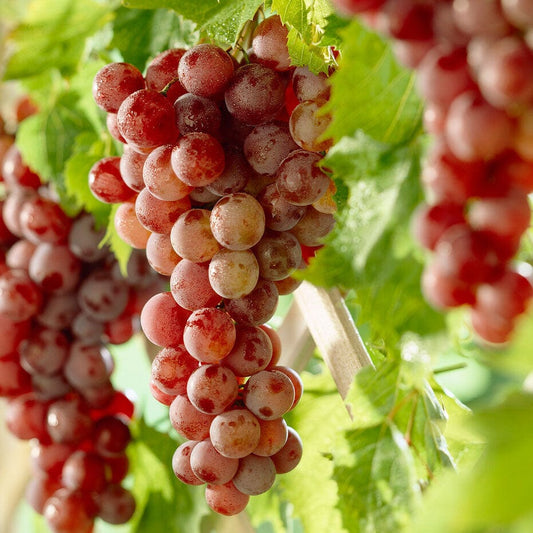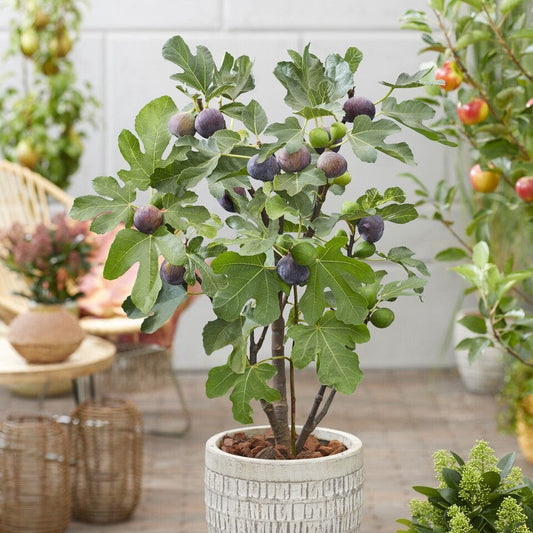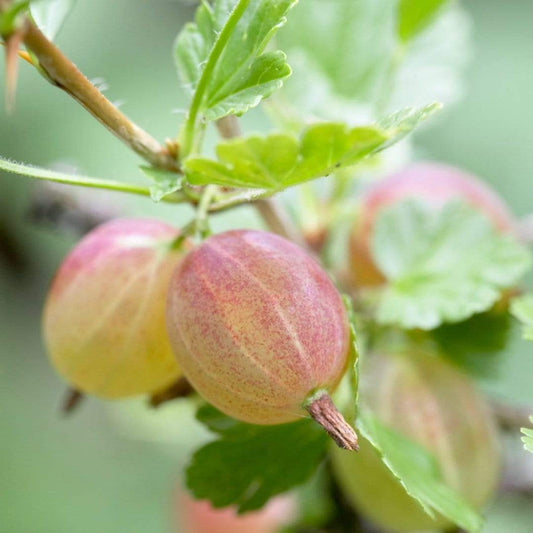Is Homegrown Fruit Better Than Supermarket Fruit?
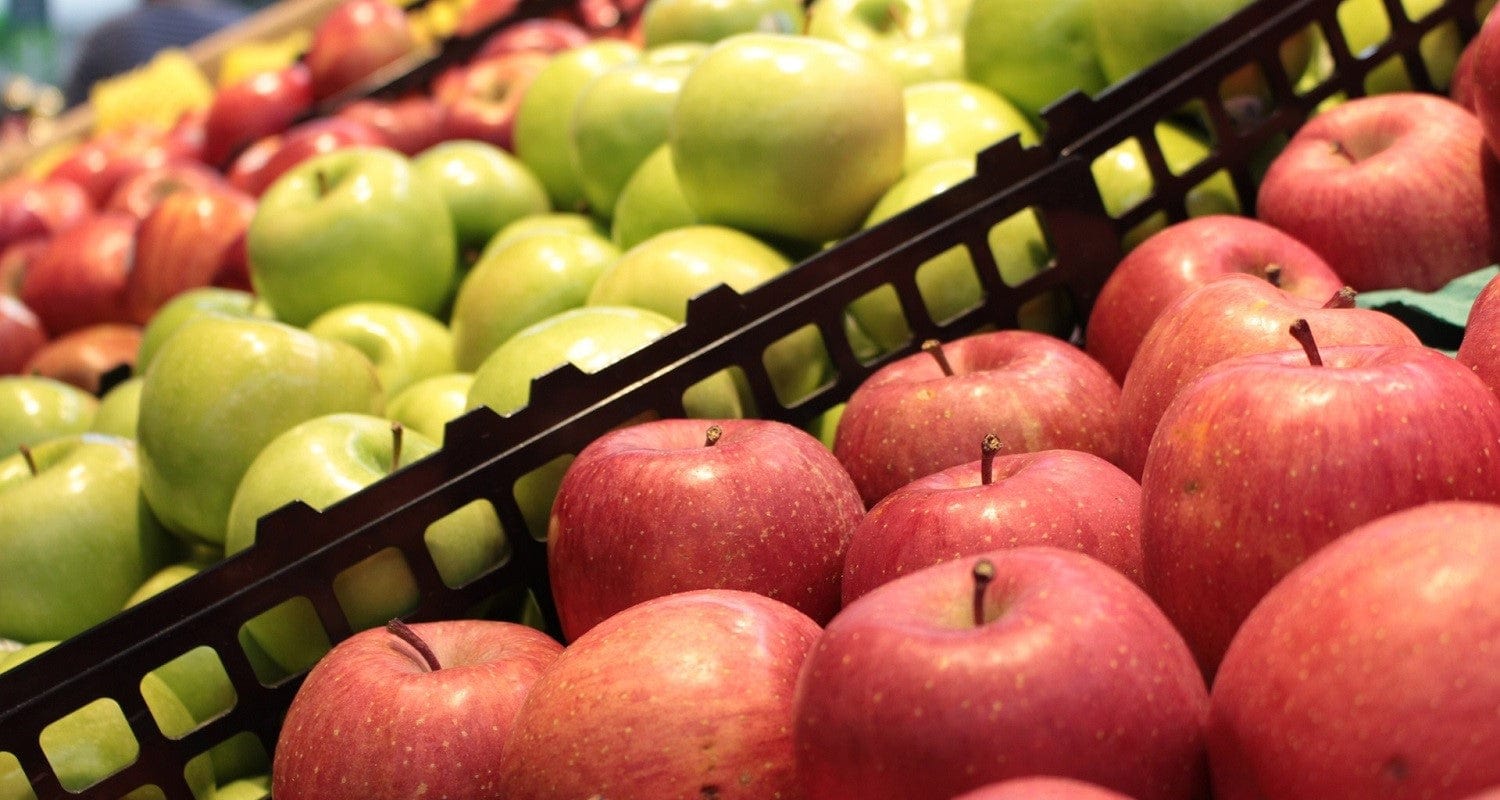
It is a truth universally acknowledged that homegrown fruit tastes better than anything you can buy (Jane Austen agreed) but why is this the case? Supermarket fruit looks good, but why are we so often disappointed when we eat it? We take a look at the facts and share our growers’ recommendations for the best fruits you won’t find within 100m of shrinkwrap…
Jump to:
- The downsides of supermarket fruit
- Why grow your own?
- The best fruits to grow at home
- The downsides of homegrowing
The downsides of supermarket fruit
Supermarket fruit is not bred for flavour
Shoppers have no choice but to select their fruit by sight, not taste - so that’s what the supermarkets focus on. Their fruit varieties are chosen for uniform size, good cropping ability, cheap, fast production and good looks, which is understandable given the scale of their business but doesn’t make for the best flavour. Compare a huge Elsanta strawberry grown in Spain out of season with a slow-ripened, perfectly formed Scottish Honeoye or Cambridge Favourite picked in June and they’re like different species.
Supermarket fruit is stored longer
The nutritional value of fruit is highest immediately after picking, and that decreases the longer it’s kept before eating. That’s why it’s treated with chlorine or taken off the shelves and plunged into cold storage every night. Sure it’ll keep longer, but at what price in terms of health?
Supermarket fruit is picked unripe
Fruit needs time on the tree to develop its sugars and ripen to full sweetness, but you can’t pack perfectly ripe pears in a crate, freight them across the world to a distribution depot and display them on the shelves for a week - they’d rot on the plane. The shops’ solution is to pick them while they’re unripe, chill them and then just before they hit the shelf, spray them with ethylene to ripen them artificially. It’s a great way to extend shelf life and reduce wastage, but pretty much destroys the flavour.
Supermarket fruit costs more
Supermarkets don’t do seasonal eating - customers demand a wide range of fruits throughout the year so they import apples from New Zealand, strawberries from Spain and peaches from Greece - alternatively, they might have been grown in heated greenhouses in Europe. Whichever method is used, the costs of greenhouse heating, electric chilling or air freighting is all passed down to the consumer - as is the cost of packaging and the natural wastage caused by transport, handling and long storage.
Supermarkets don’t take risks
They’re not going to stock something like an Egremont Russet which the majority of people have never heard of, because it won’t sell in large enough quantities. Like many lovely old heritage fruits, Egremonts might not be eye-catching on the shelf, but are highly prized for their exquisite, complex flavour. What will get stocked is big shiny apples like the heavily marketed Pink Lady and the misnamed Red Delicious which have shelf appeal but taste like sugar water and have tough skins.
It might not even be vegan
You’d think you were pretty safe with oranges and apples, wouldn’t you? Sigh. Some shop-bought fruit - including apples, pears, citrus fruit and avocados - is coated with beeswax to improve its shelf life and make it look shinier, rendering it inedible for vegans (and annoying for cooks, who now have to look out for unwaxed lemons).

Why grow your own?
More variety
You won’t find much that’s out of the ordinary in the shops, but if you want to grow pink blueberries, yellow raspberries, red kiwi fruit or stripy figs you can do all of this and more very easily at home. You can also grow your own heritage fruits - the ones that farmers handed down from generation to generation because they tasted so good but were edged out of popularity because they don’t keep for months and wouldn’t survive being thrown around the hold of an aeroplane. Freed from the tyranny of samey-looking produce, why not grow an ugly but delicious fruit like a medlar or a fabulously weird hybrid berry? Experimenting is half the fun!
Better taste
The fresher the fruit, the better it tastes and the more nutritional value it retains.
Maximise the taste by leaving your fruit on the tree until it’s fully ripe, then either eating it the same day or preserving it for later.
No pesticides
A report from Pesticide Action Network in 2021 revealed that many of the fruits and vegetables we buy regularly from supermarkets had traces of pesticides hazardous to human health - grapes topped the list with over 87% of those sampled being contaminated, with oranges and pears also listed among the worst offenders. The only way to avoid these chemical contaminants is to buy organic or grow your own.
No packaging
So the blueberries on my patio can survive birds, insects, weeds, diseases, rain, wind and sun but the ones in the supermarket need to be encased in non-recyclable plastic lined with a piece of glued-in bubble wrap. OK then…
The excessive packaging used by the shops gives you some idea of what that fruit goes through to reach the shelf - it’s there to protect the blueberries from bruising and squashing through rough handling and extremes of temperature on their journey - I’d rather sprinkle them on my porridge still warm from the plant.
Preserving heritage varieties
You won’t get an exquisite, nutty-tasting Blenheim Orange apple in the shops because it doesn’t last long enough in a cold storage unit. Sadly, this means that many of our traditional fruit varieties are in danger of being forgotten just because they don’t produce what the supermarkets demand - the heritage apple may have a complex flavour profile to make a food critic weep, or produce the best cider this side of Somerset but where’s the profit in that? By growing heritage varieties, you’re not only getting a better quality of fruit, you’re helping to stop them disappearing forever. It’s like adopting a gorilla from one of those wildlife charities but with a hundred years’ worth of apples instead of a cuddly toy and a certificate.
More nutrients
When you consider the length of time it takes supermarket fruit to reach the shelves and how long it stays there before you choose it, it’s no wonder half the vitamins and minerals have left the building by the time it gets to your plate. Fruit derives its nutrients from the soil or the plant it's attached to, so the content therefore starts to drop at the moment it’s separated - Vitamin C is particularly sensitive to this. In contrast, you can eat a homegrown raspberry seconds after picking it, so it retains all of its nutrients (and it won’t go mushy).
No air miles
A bunch of grapes from South Africa will travel around 8,000 miles to reach your cheeseboard, compared to grapes harvested from your own greenhouse, which should come in at closer to eight steps and a bit of reaching upwards.
And not forgetting… growing is fun!
Growing your own gets you outside in the fresh air doing physical work, which always makes me feel good. I love watching my plants and trees grow and change throughout the seasons, from spring blossom to autumn leaf fall, as well as enjoying the birds and insects they attract to my garden. And obviously I also love photographing my crops for likes on Instagram.
Our favourite fruits that you can’t buy in the shops
These are our growers’ best picks for fruit that’s not widely available in shops. These lovely heritage and bred-for-taste varieties might be smaller or less shiny, have a weird name or simply wouldn’t survive a long journey in an 18 wheeler followed by a week in a fridge and a generous spritz of ethylene. At any rate, every one of these is a gamechanger in terms of flavour.
'Blenheim Orange' Apple Tree
This late season apple dates back to the 18th century and has a tangy, nutty flavour. It’s an excellent choice for eating fresh or cooking down.
Doyenné Du Comice Pear Tree
Gourmet pear with a delicious aromatic flavour and the kind of meltingly soft flesh that wouldn’t end well in shrink wrap.
All Gold Raspberry Plants
Golden yellow raspberries to harvest from August onwards, these award winning fruits taste as good as they look with no packaging needed.
Pink Lemonade Blueberry Bush
Blueberries that taste like pink lemonade - and are actually pink - on a compact patio plant with attractive foliage and flowers.
'Muscat of Alexandria' Grape Vine
One of the world’s oldest varieties, this golden-green grape dates back centuries to when the ancient Egyptians made wine from it.
Old Greengage Plum Tree
Fabulously versatile old English fruit widely considered to have the best flavour of any plum or gage in the world but y’know, it’s green, eww so Tesco won’t go there.
The downsides of homegrowing
No strawberries in winter
Seasonal eating takes a little getting used to - you’ll have a lot of fruit in summer (possibly too much) but if you want to eat it all year round you’ll have to grow it indoors or in a heated greenhouse or polytunnel - unless you get clever with the preserving, like Grandma used to.
Storage
Because your crop is fresh, you’ll need to store it in a cool place (hard fruits) or a fridge (soft fruits) if you want to eat it later. Soft fruits will only keep for a few days and tree fruits like apples and pears for up to a few months. Luckily there are many ways of preserving your crop - that way you get to enjoy it all year round too. The most traditional methods of preserving are bottling and making jam, but other techniques like drying and making fruit leather are also becoming popular again - and of course you could just do what I do and freeze it all (perfect for smoothies). Probably the heaviest cropping fruit is plums - check out our tips on dealing with a mega harvest!

It takes time for a decent crop
Becoming self-sufficient doesn’t happen overnight - you’ll need to wait until your plants are mature enough to produce fruit. Most soft fruits will give you plenty in their first season but tree fruits take at least a couple of years to crop in great quantities. While you’re waiting, buy from farm shops, greengrocers or a market. Their produce will be much fresher and you’ll usually find a better range - and if you’re lucky enough to live near allotments, the growers will often sell their excess produce at a good price.
With a little work and planning, you can get all the benefits of home grown with the all-year-round variety and storage quality of bought. Plant fruit trees today and combine them with some quick-yielding soft fruits to eat while you wait - in no time you’ll be harvesting and sharing with other local growers and enjoying the best fruit you ever tasted.
Last updated: 08/01/2026

